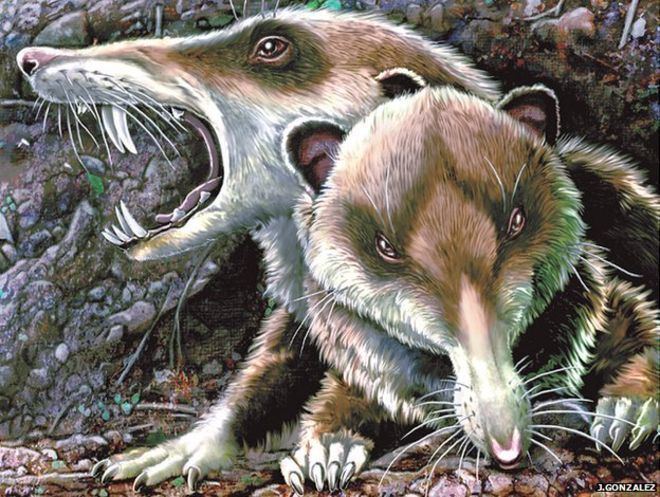An international team of paleontologists has resolved the evolutionary relationships of strange prehistoric mammal Necrolestes patagonensis.

This illustration shows the Miocene mammal Necrolestes patagonensis venturing out of its burrow 16 million years ago in Patagonia, present-day Argentina. Necrolestes is now recognized as a member of a group long thought to have become extinct shortly after the extinction of the large dinosaurs at the end of the Cretaceous period (Jorge Gonzalez / Guillermo Rougier)
Since its discovery in Patagonia in 1891, Necrolestes has been a paleontological riddle for more than 120 years.

“Necrolestes is one of those animals in the textbooks that would appear with a picture and a footnote, and the footnote would say: we don’t know what it is,” said Dr John Wible of Carnegie Museum of Natural History, co-author of the study published in the Proceedings of the National Academy of Sciences.
Despite being excellently preserved, the mysterious fossils moved from institution to institution and researcher to researcher, the classification of Necrolestes changing with each new move. As recently as a few years ago, the creature still could not be definitively classified in a mammal group. A 2008 study led to hypothesis that Necrolestes was a marsupial.

This classification intrigued study co-author Dr Guillermo Rougier of the University of Louisville, Kentucky. As a specialist in South American mammals, he was not convinced that the marsupial identification was accurate, and embarked on his own attempt to make a classification.
“This project was a little daunting, because we had to contradict 100 years of interpretation,” Dr Rougier said.
The team uncovered characteristics of the Necrolestes’ skull anatomy that had previously gone unnoted, and came to the groundbreaking realization that Necrolestes belonged to neither the marsupial nor placental lineages to which it had historically been linked. Rather, Necrolestes actually belonged in a completely unexpected branch of the evolutionary tree which was thought to have died out 45 million years earlier than the time of Necrolestes.
In 2011, Dr Rougier discovered an extinct mammal Cronopio, which belonged to the Meridiolestida, a little-known group of mammals found in South America in the Late Cretaceous and early Paleocene some 100–60 million years ago.


The team found that Cronopio and Necrolestes share many features in common, including the fact that they are the only known mammals to have single-rooted molars. This conclusively showed that Necrolestes was neither a marsupial nor a placental mammal, and was in fact the last remaining member of the Meridiolestida lineage, thought to have gone extinct 45 million years earlier.
“If we didn’t know those fossils,” said Dr Wible of Cronopio, “we might have come to the same conclusion that everybody else had – that the relationships of Necrolestes were unknowable.”

The mass extinction that ended the Age of Dinosaurs wiped out thousands of species. Included in the devastation were the Meridiolestida, the mammal group to which Cronopio and Necrolestes belong, cutting short their evolutionary lineage – or so scientists thought.
Before the conclusive identification of Necrolestes, only one member of the Meridiolestida was known to have survived the extinction event, and that species died out soon after, early in the Tertiary Period (65–1.8 million years ago). Necrolestes is therefore the only remaining member of a supposedly extinct group.
“It’s the supreme Lazarus effect,” Dr Wible said. “How in the world did this animal survive so long without anyone knowing about it?”
In the Lazarus effect, a species previously thought to be extinct is rediscovered – sometimes living, sometimes elsewhere in the fossil record. The Lazarus effect is well represented by the ginkgo tree, thought to be extinct until it was rediscovered growing in China in the 17th century.
Source: sci.news








